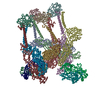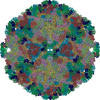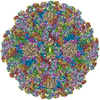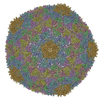[English] 日本語
 Yorodumi
Yorodumi- PDB-7cvz: Cryo-EM structure of Chikungunya virus in complex with Fab fragme... -
+ Open data
Open data
- Basic information
Basic information
| Entry | Database: PDB / ID: 7cvz | ||||||
|---|---|---|---|---|---|---|---|
| Title | Cryo-EM structure of Chikungunya virus in complex with Fab fragments of mAb CHK-263 | ||||||
 Components Components |
| ||||||
 Keywords Keywords | VIRUS/IMMUNE SYSTEM /  virus / virus /  Fab / Fab /  complex / VIRUS-IMMUNE SYSTEM complex complex / VIRUS-IMMUNE SYSTEM complex | ||||||
| Function / homology |  Function and homology information Function and homology information togavirin / T=4 icosahedral viral capsid / symbiont-mediated suppression of host toll-like receptor signaling pathway / host cell cytoplasm / symbiont entry into host cell / serine-type endopeptidase activity / fusion of virus membrane with host endosome membrane / host cell nucleus / virion attachment to host cell / host cell plasma membrane ... togavirin / T=4 icosahedral viral capsid / symbiont-mediated suppression of host toll-like receptor signaling pathway / host cell cytoplasm / symbiont entry into host cell / serine-type endopeptidase activity / fusion of virus membrane with host endosome membrane / host cell nucleus / virion attachment to host cell / host cell plasma membrane ... togavirin / T=4 icosahedral viral capsid / symbiont-mediated suppression of host toll-like receptor signaling pathway / host cell cytoplasm / symbiont entry into host cell / serine-type endopeptidase activity / fusion of virus membrane with host endosome membrane / host cell nucleus / virion attachment to host cell / host cell plasma membrane / virion membrane / structural molecule activity / togavirin / T=4 icosahedral viral capsid / symbiont-mediated suppression of host toll-like receptor signaling pathway / host cell cytoplasm / symbiont entry into host cell / serine-type endopeptidase activity / fusion of virus membrane with host endosome membrane / host cell nucleus / virion attachment to host cell / host cell plasma membrane / virion membrane / structural molecule activity /  proteolysis / proteolysis /  RNA binding / RNA binding /  membrane / membrane /  plasma membrane / plasma membrane /  cytoplasm cytoplasmSimilarity search - Function | ||||||
| Biological species |    Chikungunya virus Chikungunya virus  Mus musculus (house mouse) Mus musculus (house mouse) | ||||||
| Method |  ELECTRON MICROSCOPY / ELECTRON MICROSCOPY /  single particle reconstruction / single particle reconstruction /  cryo EM / Resolution: 4.7 Å cryo EM / Resolution: 4.7 Å | ||||||
 Authors Authors | Zhou, Q.F. / Fox, J.M. / Earnest, J.T. / Ng, T.S. / Kim, A.S. / Fibriansah, G. / Kostyuchenko, V.A. / Shu, B. / Diamond, M.S. / Lok, S.M. | ||||||
| Funding support |  Singapore, 1items Singapore, 1items
| ||||||
 Citation Citation |  Journal: Proc Natl Acad Sci U S A / Year: 2020 Journal: Proc Natl Acad Sci U S A / Year: 2020Title: Structural basis of Chikungunya virus inhibition by monoclonal antibodies. Authors: Qun Fei Zhou / Julie M Fox / James T Earnest / Thiam-Seng Ng / Arthur S Kim / Guntur Fibriansah / Victor A Kostyuchenko / Jian Shi / Bo Shu / Michael S Diamond / Shee-Mei Lok /   Abstract: Chikungunya virus (CHIKV) is an emerging viral pathogen that causes both acute and chronic debilitating arthritis. Here, we describe the functional and structural basis as to how two anti-CHIKV ...Chikungunya virus (CHIKV) is an emerging viral pathogen that causes both acute and chronic debilitating arthritis. Here, we describe the functional and structural basis as to how two anti-CHIKV monoclonal antibodies, CHK-124 and CHK-263, potently inhibit CHIKV infection in vitro and in vivo. Our in vitro studies show that CHK-124 and CHK-263 block CHIKV at multiple stages of viral infection. CHK-124 aggregates virus particles and blocks attachment. Also, due to antibody-induced virus aggregation, fusion with endosomes and egress are inhibited. CHK-263 neutralizes CHIKV infection mainly by blocking virus attachment and fusion. To determine the structural basis of neutralization, we generated cryogenic electron microscopy reconstructions of Fab:CHIKV complexes at 4- to 5-Å resolution. CHK-124 binds to the E2 domain B and overlaps with the Mxra8 receptor-binding site. CHK-263 blocks fusion by binding an epitope that spans across E1 and E2 and locks the heterodimer together, likely preventing structural rearrangements required for fusion. These results provide structural insight as to how neutralizing antibody engagement of CHIKV inhibits different stages of the viral life cycle, which could inform vaccine and therapeutic design. | ||||||
| History |
|
- Structure visualization
Structure visualization
| Movie |
 Movie viewer Movie viewer |
|---|---|
| Structure viewer | Molecule:  Molmil Molmil Jmol/JSmol Jmol/JSmol |
- Downloads & links
Downloads & links
- Download
Download
| PDBx/mmCIF format |  7cvz.cif.gz 7cvz.cif.gz | 183.8 KB | Display |  PDBx/mmCIF format PDBx/mmCIF format |
|---|---|---|---|---|
| PDB format |  pdb7cvz.ent.gz pdb7cvz.ent.gz | 112.7 KB | Display |  PDB format PDB format |
| PDBx/mmJSON format |  7cvz.json.gz 7cvz.json.gz | Tree view |  PDBx/mmJSON format PDBx/mmJSON format | |
| Others |  Other downloads Other downloads |
-Validation report
| Arichive directory |  https://data.pdbj.org/pub/pdb/validation_reports/cv/7cvz https://data.pdbj.org/pub/pdb/validation_reports/cv/7cvz ftp://data.pdbj.org/pub/pdb/validation_reports/cv/7cvz ftp://data.pdbj.org/pub/pdb/validation_reports/cv/7cvz | HTTPS FTP |
|---|
-Related structure data
| Related structure data |  30477MC  7cvyC  7cw0C  7cw2C  7cw3C C: citing same article ( M: map data used to model this data |
|---|---|
| Similar structure data |
- Links
Links
- Assembly
Assembly
| Deposited unit | 
|
|---|---|
| 1 | x 60
|
| 2 |
|
| 3 | x 5
|
| 4 | x 6
|
| 5 | 
|
| Symmetry | Point symmetry: (Schoenflies symbol : I (icosahedral : I (icosahedral )) )) |
- Components
Components
| #1: Protein | Mass: 47503.016 Da / Num. of mol.: 4 / Source method: isolated from a natural source / Source: (natural)    Chikungunya virus / References: UniProt: Q8JUX5*PLUS Chikungunya virus / References: UniProt: Q8JUX5*PLUS#2: Protein | Mass: 46904.559 Da / Num. of mol.: 4 / Source method: isolated from a natural source / Source: (natural)    Chikungunya virus / References: UniProt: Q8JUX5*PLUS, Chikungunya virus / References: UniProt: Q8JUX5*PLUS,  togavirin togavirin#3: Protein |  Capsid / Togavirin / Coordinate model: Cα atoms only Capsid / Togavirin / Coordinate model: Cα atoms onlyMass: 16428.607 Da / Num. of mol.: 4 / Source method: isolated from a natural source / Source: (natural)    Chikungunya virus Chikungunya virusReferences: UniProt: A0A6B9KBE1, UniProt: Q8JUX5*PLUS,  togavirin togavirin#4: Antibody |  Fragment antigen-binding / Coordinate model: Cα atoms only Fragment antigen-binding / Coordinate model: Cα atoms onlyMass: 22872.670 Da / Num. of mol.: 2 / Source method: isolated from a natural source / Source: (natural)   Mus musculus (house mouse) Mus musculus (house mouse)#5: Antibody |  Fragment antigen-binding / Coordinate model: Cα atoms only Fragment antigen-binding / Coordinate model: Cα atoms onlyMass: 23381.570 Da / Num. of mol.: 2 / Source method: isolated from a natural source / Source: (natural)   Mus musculus (house mouse) Mus musculus (house mouse) |
|---|
-Experimental details
-Experiment
| Experiment | Method:  ELECTRON MICROSCOPY ELECTRON MICROSCOPY |
|---|---|
| EM experiment | Aggregation state: PARTICLE / 3D reconstruction method:  single particle reconstruction single particle reconstruction |
- Sample preparation
Sample preparation
| Component |
| ||||||||||||||||||||||||
|---|---|---|---|---|---|---|---|---|---|---|---|---|---|---|---|---|---|---|---|---|---|---|---|---|---|
| Molecular weight |
| ||||||||||||||||||||||||
| Source (natural) |
| ||||||||||||||||||||||||
| Buffer solution | pH: 8 | ||||||||||||||||||||||||
| Specimen | Embedding applied: NO / Shadowing applied: NO / Staining applied : NO / Vitrification applied : NO / Vitrification applied : YES : YES | ||||||||||||||||||||||||
Vitrification | Cryogen name: ETHANE |
- Electron microscopy imaging
Electron microscopy imaging
| Experimental equipment |  Model: Titan Krios / Image courtesy: FEI Company |
|---|---|
| Microscopy | Model: FEI TITAN KRIOS |
| Electron gun | Electron source : :  FIELD EMISSION GUN / Accelerating voltage: 300 kV / Illumination mode: FLOOD BEAM FIELD EMISSION GUN / Accelerating voltage: 300 kV / Illumination mode: FLOOD BEAM |
| Electron lens | Mode: BRIGHT FIELD Bright-field microscopy Bright-field microscopy |
| Image recording | Electron dose: 20 e/Å2 / Film or detector model: FEI FALCON II (4k x 4k) |
- Processing
Processing
| Software | Name: PHENIX / Version: 1.18_3845: / Classification: refinement | ||||||||||||||||||||||||
|---|---|---|---|---|---|---|---|---|---|---|---|---|---|---|---|---|---|---|---|---|---|---|---|---|---|
CTF correction | Type: PHASE FLIPPING AND AMPLITUDE CORRECTION | ||||||||||||||||||||||||
3D reconstruction | Resolution: 4.7 Å / Resolution method: FSC 0.143 CUT-OFF / Num. of particles: 164158 / Symmetry type: POINT | ||||||||||||||||||||||||
| Refine LS restraints |
|
 Movie
Movie Controller
Controller














 PDBj
PDBj




